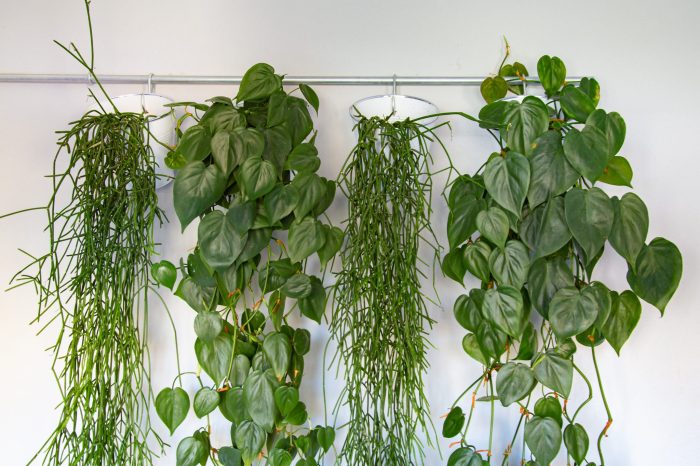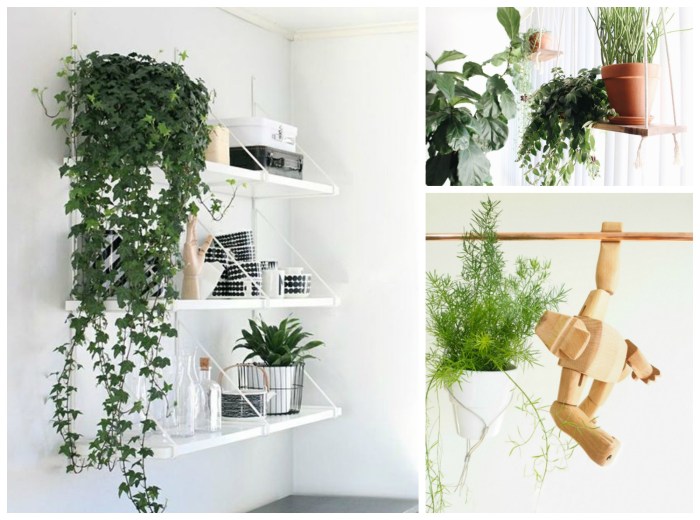As hanging trailing plants take center stage, this comprehensive guide invites you on a journey to explore their captivating beauty, unravel their care secrets, and discover their transformative power in interior and exterior spaces.
From cascading tendrils to vibrant foliage, hanging trailing plants bring a touch of nature’s grace to any setting, offering a wealth of design possibilities and endless opportunities for creative expression.
Types of Hanging Trailing Plants

Hanging trailing plants add a touch of greenery and elegance to any space. They come in various types, each with unique characteristics and care requirements. Whether you prefer lush foliage, vibrant blooms, or easy maintenance, there’s a hanging trailing plant perfect for your needs.
Popular Hanging Trailing Plants
*
Hanging trailing plants can add a touch of greenery and freshness to any indoor space. For a more stylish and functional option, consider using hanging glass planters. These planters allow you to display your plants in a unique way while also providing them with the necessary light and support.
Learn more about the benefits and styles of hanging glass planters in our comprehensive guide: Hanging Glass Planters: Elevate Your Indoor Decor with Style and Functionality . With hanging trailing plants in these elegant glass planters, you can create a lush and inviting atmosphere in your home.
-*Spider Plant (Chlorophytum comosum)
Known for its long, arching leaves with white or green stripes, spider plants are easy to care for and produce baby plants called “spiderettes.”
-
-*Pothos (Epipremnum aureum)
With heart-shaped leaves that come in a variety of colors, pothos is a low-maintenance plant that tolerates low light conditions.
-*String of Pearls (Senecio rowleyanus)
This unique plant features plump, spherical leaves that resemble strings of pearls. It prefers bright, indirect light and well-draining soil.
-*Trailing Jade (Senecio mandraliscae)
With fleshy, teardrop-shaped leaves, trailing jade is a succulent that can tolerate both indoor and outdoor conditions. It prefers bright light and occasional watering.
-*Wandering Jew (Tradescantia zebrina)
This colorful plant has striped leaves in shades of purple, green, and silver. It prefers bright, indirect light and can grow both indoors and outdoors.
Care and Maintenance

Maintaining hanging trailing plants requires attention to watering, fertilizing, and pruning. Understanding their specific needs ensures optimal growth and a healthy appearance.
Watering
Hanging trailing plants typically require moderate watering. Allow the top few inches of soil to dry out between waterings. Overwatering can lead to root rot, so it’s crucial to avoid keeping the soil constantly moist.
Fertilizing
Fertilize hanging trailing plants monthly during the growing season with a balanced liquid fertilizer. Avoid over-fertilizing, as it can burn the roots.
Pruning
Regular pruning encourages bushy growth and controls the spread of the plants. Trim back any dead or overgrown stems, and pinch off the tips of healthy stems to promote branching.
Hanging trailing plants can add a touch of greenery and elegance to any room. Whether you’re looking to create a lush indoor jungle or simply add some life to a bare corner, IKEA Indoor Plant Hangers: Elevate Your Home Decor with Style and Functionality has a wide range of options to choose from.
From simple hooks to elaborate macrame designs, there’s sure to be a hanger that perfectly complements your plants and your home decor.
Growth Management
To manage the growth and spread of hanging trailing plants, consider using trellises or hanging baskets. Trellises provide support for the stems to climb, while hanging baskets keep the plants contained and prevent them from trailing too far.
Hanging trailing plants can add a touch of elegance and greenery to any home. Whether you choose to suspend them from the ceiling or place them on a shelf, these plants can create a dramatic effect. For those looking for more information on Hanging plants, there are numerous resources available online that can provide tips on choosing the right plants, caring for them, and creating beautiful displays.
Pests and Diseases
Common pests that affect hanging trailing plants include aphids, mealybugs, and spider mites. Treat infestations promptly with insecticidal soap or neem oil. Diseases such as powdery mildew and root rot can also occur. Ensure proper watering and ventilation to prevent these issues.
Design Ideas and Inspiration
Hanging trailing plants are versatile decorative elements that can transform any space. They bring a touch of nature indoors, adding life and freshness to any room. When used creatively, they can create stunning visual displays that enhance the overall ambiance of a space.
From bohemian to modern and rustic styles, hanging trailing plants can be incorporated into various decor themes. They can be used to create a cozy and inviting atmosphere, add a touch of elegance, or bring a bit of the outdoors in.
The possibilities are endless, limited only by one’s imagination.
Stunning Examples of Hanging Trailing Plants in Interior Spaces
- Macrame hangers:Suspend trailing plants in macrame hangers for a bohemian touch. The intricate knots and patterns of the macrame create a beautiful backdrop for the lush greenery.
- Shelving units:Utilize shelving units to display hanging trailing plants at different heights. This creates a dynamic and eye-catching display that adds depth and interest to a room.
- Wall-mounted planters:Mount planters on walls to create a vertical garden effect. Trailing plants cascading down the wall add a touch of greenery and freshness to any space.
Incorporating Hanging Trailing Plants into Exterior Spaces
- Pergolas and arbors:Create a lush and inviting outdoor space by draping trailing plants over pergolas and arbors. The plants provide shade and privacy while adding a touch of beauty.
- Balconies and patios:Transform balconies and patios into green oases by hanging trailing plants from the railings or ceiling. They add a pop of color and create a relaxing and inviting atmosphere.
- Fences and walls:Conceal unsightly fences and walls with trailing plants. The greenery softens the edges and creates a more natural and welcoming look.
Creative Combinations and Decorative Elements
To create eye-catching displays, experiment with combining different types of hanging trailing plants. Mix and match textures, colors, and shapes to create a unique and personalized look.
Incorporate other decorative elements such as fairy lights, wind chimes, or colorful pots to enhance the visual appeal. These elements add a touch of whimsy and charm to the overall display.
Propagation Techniques: Hanging Trailing Plants

Propagating hanging trailing plants is a rewarding way to increase your plant collection and share your favorites with friends. Several methods can be used to propagate these plants, including stem cuttings, division, and layering.
Stem Cuttings
Stem cuttings are the most common method of propagating hanging trailing plants. To take a stem cutting, select a healthy stem that is at least 4 inches long. Remove the leaves from the bottom 1-2 inches of the stem and dip the cut end in rooting hormone.
Plant the cutting in a well-draining potting mix and keep it moist. The cutting should root within 2-3 weeks.
Hanging trailing plants can add a touch of greenery and life to any indoor space. For those looking to enhance their home decor with these beautiful plants, Indoor Hanging Plants for Sale: Enhance Your Home with Greenery offers a wide selection of hanging trailing plants for sale.
These plants come in a variety of shapes, sizes, and colors, making them perfect for any room in the house. Whether you’re looking for a statement piece or a subtle addition to your decor, hanging trailing plants are a great way to bring nature indoors.
Division
Division is another easy way to propagate hanging trailing plants. To divide a plant, remove it from its pot and gently separate the roots into two or more sections. Each section should have its own roots and at least one stem.
Plant the divisions in individual pots filled with a well-draining potting mix.
Layering
Layering is a method of propagation that involves rooting a stem while it is still attached to the mother plant. To layer a hanging trailing plant, select a long stem and bend it down to the soil. Make a small cut in the stem where it will touch the soil and cover the cut with a handful of moist potting mix.
Keep the potting mix moist, and the stem should root within 4-6 weeks. Once the stem has rooted, you can cut it from the mother plant and pot it up.The best time of year to propagate hanging trailing plants is in the spring or summer when the plants are actively growing.
However, some plants can be propagated year-round. When propagating hanging trailing plants, it is essential to use a well-draining potting mix and keep the plants moist. Providing the plants with bright, indirect light will also help them to root and grow.
DIY Projects and Crafts
Hanging trailing plants offer a versatile canvas for creative DIY projects and crafts. From living wall art to macrame plant hangers and kokedama moss balls, these projects add a touch of greenery and personality to any space.
Living Wall Art
Transform a bare wall into a living masterpiece with a DIY living wall art project. Start by gathering a variety of hanging trailing plants, such as pothos, ivy, or ferns. Create a grid or pattern on the wall and secure plant pots or containers using screws or hooks.
Fill the containers with soil and carefully plant the trailing plants. Water regularly and enjoy the vibrant wall art that purifies the air and adds a touch of nature indoors.
Macrame Plant Hangers
Macrame plant hangers are a stylish and sustainable way to display hanging trailing plants. Using simple macrame knots, create intricate hangers that suspend plants from the ceiling or walls. Choose a variety of cord colors and textures to match your decor and personalize the hangers.
Experiment with different knotting patterns to create unique and eye-catching designs.
Kokedama Moss Balls
Kokedama, the Japanese art of moss balls, is a unique and elegant way to display hanging trailing plants. Wrap a ball of sphagnum moss around the root ball of a plant, securing it with twine or thread. Create a small hole in the moss ball and insert a hook or wire for hanging.
Water regularly and enjoy the serene beauty of these living sculptures.
Final Wrap-Up
Whether you’re a seasoned plant enthusiast or a budding gardener, this guide provides an indispensable resource for harnessing the beauty of hanging trailing plants. Embrace their versatility, elevate your living spaces, and create enchanting environments that inspire tranquility and delight.
FAQ Explained
What are the most popular types of hanging trailing plants?
Some of the most popular hanging trailing plants include pothos, philodendron, ivy, spider plants, and ferns.
How often should I water my hanging trailing plants?
The watering frequency for hanging trailing plants varies depending on the species and the environment. Generally, they prefer to dry out slightly between waterings.
How can I propagate hanging trailing plants?
Hanging trailing plants can be propagated through stem cuttings, division, or layering. Stem cuttings are the most common method.